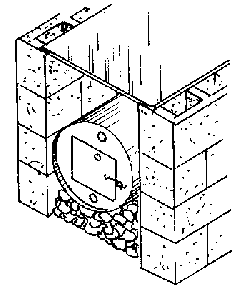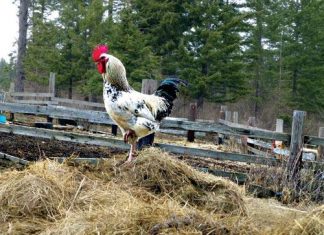| Issue #41 • September/October, 1996 |
The thing I like the most about Backwoods Home is that, unlike a lot of other magazines, the articles are written by folks who are actually doing the things they write about. Folks like Massad Ayoob, Don Fallick, and Dynah Geissal have already learned their stuff by trial and error, which can save the rest of us the time, troubles, and expenses of initial experimentation. It’s good to fool around with new ideas, but we can use other folks’ experience as proven starting points, and then adapt our own ideas and improvements into their concepts. As an example of building on someone else’s experience, let me tell you how I ended up building the perfect large-quantity food dehydrator.
 1. Dry-stack block to make three walls. Rest the barrel on a bed of stones. Set 4x4s in the corners and sheet steel on top. 1. Dry-stack block to make three walls. Rest the barrel on a bed of stones. Set 4x4s in the corners and sheet steel on top. |
Since our garden, fruit trees, strawberry patches, etc., have always produced abundantly for us, we’ve worked at developing the skills to preserve this abundance from one harvest to the next. Canning and freezing only go so far, so for a couple of years we fooled around with various types of dehydrators. The relatively inexpensive Ronco brand electric dehydrator we purchased at an area gun show works great for small quantities, and we find it very useful for that.
However, solar dehydrators turned out to be an entirely different story. I can tell you from experience that unless you’re living somewhere like one of our southwestern deserts, where you can depend on plenty of hot, dry weather for lengthy periods, solar dryers (whether purchased or owner-built) just aren’t dependable enough for real backwoods-type use. As a result, I fooled around with several other ideas, but none of them worked out to our satisfaction.
I might have given up on the idea entirely had it not been for the intervention of an elderly friend whose family has owned and operated an apple orchard for several generations. Not only did this gentleman show me more than I’d ever thought of knowing about apple varieties (best choices for eating, baking, sweet and hard cider, applejack, etc.), but he also showed me what was left of the big wood-fired fruit dryers that his father and grandfather had used in the days before electric refrigeration, large commercial canneries, and such. While he explained how they were used, we looked them over. Remembering from his early youth, he also told me how his family, and other large commercial growers, would dry many tons of fruit every year. Demand always outran what they were able to supply.
 2. Install supports for trays. 2. Install supports for trays. |
Though the dryers on his property had pretty much fallen apart from years of decay and neglect, some simple measurements showed me that, when up and running, each one would have been easily capable of holding 30 bushels of produce. He assured me that regardless of the weather conditions, 24 hours was the maximum drying time, even for the juiciest fruit.
Although 30 bushels seemed much more than we’d ever need to dry in one shot, it was easy to see how such a simple wood-fueled dehydrator could be built in practically any size. There was a heat source at the bottom with interchangeable drying trays arranged over it, with eave vents and a sort of cupola vent on the roof (kind of like what you see on many older barns) to allow the rising warmed air to carry away the moisture from the drying fruit. I later learned that on cool nights, you can watch the vapor escape from these vents.
 3. Cover three sides with plywood, hinged for access. 3. Cover three sides with plywood, hinged for access. |
After tossing this idea around for a while, and fiddling with some figures to come up with a size more appropriate for our own use, I built a scaled-down version of those commercial dryers. Now, about 15 years later, it’s still serving our family’s needs perfectly. This simple design is so readily adaptable that you can include your own modifications to adapt it to your needs. So, while I’m going to detail the design that I used, remember that you can change practically any of the details and techniques to suit your own requirements and resources.
First of all, since I’d already located a reliable source for free, empty 55-gallon steel drums, I decided to build a simple barrel stove for the heat source. Laying the drum on the ground, I stacked extra-wide (16″) foundation blocks around three sides of the drum, fashioning three un-mortared walls, two blocks taller than the drum. Next, I filled in the area between these block walls with ordinary field stones to the level of the top of the first row of blocks, so as to keep the stove up off the ground.
 4. Leave openings in the fourth side for inserting and removing trays. 4. Leave openings in the fourth side for inserting and removing trays. |
I dropped 4×4 timbers into the hollows of the corner blocks and fashioned a wooden framework to hold the drying trays. On three sides of the dehydrator, I used half-inch CDX plywood to close them off completely. However, each piece is hinged at the bottom, being held shut by hook-and-eye fasteners at the tops, to allow for easy access for cleaning after each use. On the fourth side, I left openings similar to those of a chest of drawers for inserting and removing the drying trays.
Note: Since this will be used for food processing and there is heat involved, you should not use pressure-treated lumber and avoid lead-based paint.
I built the trays from 1x3s and the lids from 1x2s. I used hardware cloth for the tray bottoms and metal window screen to cover the tops, which are fastened to the trays with hinges. I also used metal window screen to cover the eave and cupola vents to further prevent any possibility of insect damage. I used painted canvas for the roofing material (as covered in the May/June 1996 issue of BHM).
 5. Install roof, vents, and stovepipe. 5. Install roof, vents, and stovepipe. |
I used a hammer and cold chisel to cut an eight-inch-diameter hole in one end of the drum for fitting a stovepipe, and I cut a square access door in the opposite end. I used cheap hinges and sheet metal screws to reattach the square of metal removed from the door opening, along with a simple hook-and-eye to hold this door shut. This works just as well as the door provided with a purchased barrel stove kit; it just doesn’t look quite so pretty. Adding a damper in the stove pipe, and being able to remove or reinsert either or both of the original barrel plugs, allows for heat control.
The most expensive part of this whole setup (and it didn’t cost that much), was a piece of 1/8″ steel cut to rest on the inside two inches of the top of the block wall. This creates a much more even distribution of heat, and the extra width of the block wall keeps the heat just far enough from the wooden outer walls.
In use, you’ll need to rotate the trays every couple hours or so. Just remove the top tray, setting it aside for a moment, and raise each of the remaining trays one position. Then take the tray you’d removed from the top, and reinsert it in the lowest position. It’s also necessary to keep a low fire going inside the stove during the entire drying process. During the day, we work in shifts, adding dry corn cobs and keeping the draft regulated as required. Then towards bedtime, we load the stove up with large, unsplit, only-partially-dried logs (remember, this is out-of-doors, not inside your living room, so a chimney fire isn’t a major problem) and damper the stove almost all the way down. At least two or three times during the night, one of us will get up to go out and reshuffle the drying trays.
Usually we begin the drying process early in the morning. That way, by the time we’re up and about the next morning, the dehydration process is normally completed.
 6. Hinge lids to trays. 6. Hinge lids to trays. |
Generally, we use dehydrated fruits and vegetables in one of two ways. There are plenty of other methods for using dried foods, but these two are our family favorites. The first method is simply to reconstitute the dried food by soaking it in water overnight, then using it in exactly the same manner as frozen food, in any recipe. This tastes a little better than using frozen fruit or vegetables, but otherwise you can’t really tell the difference. The other method we like is to run the thoroughly dried food through our hand-cranked grain mill, producing pumpkin, potato, and other specialty flours, as well as apple, tomato, carrot, onion, and other “powders,” which are terrific cooking aids.
Remember, you can vary the size, construction techniques, materials, and so forth to customize this design to fit your own circumstances. For example, you could build a really large masonry firebox, or use a smaller 30- or 15-gallon drum, or even an inverted washtub, for the heat source. You could substitute dowels, laths, or sticks for the trays, if you’ll only be making jerky, drying fish, and such. Or you could make any number of other customizations. So whatever your food storage needs might be, a similar wood-fueled dehydrator could prove just as perfect for you as ours has for us. Who knows, you might even find that there’s a market in your area for some of your delicious dried fruit.














